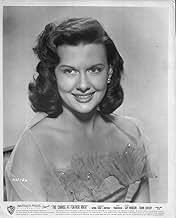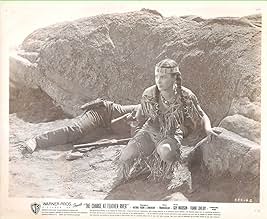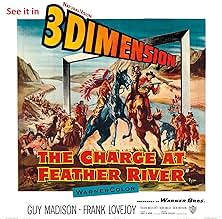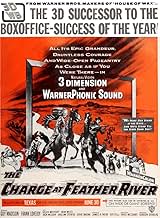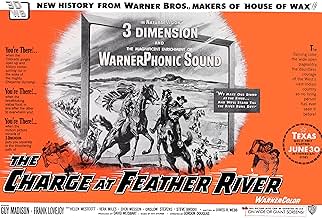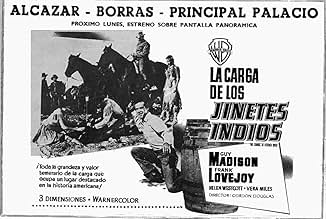Un destacamento de soldados de caballería, liderados por el sargento Baker y acompañados por el explorador Miles Archer, se adentra en territorio indio para liberar a dos hermanas que han si... Leer todoUn destacamento de soldados de caballería, liderados por el sargento Baker y acompañados por el explorador Miles Archer, se adentra en territorio indio para liberar a dos hermanas que han sido capturadas por los cheyennes.Un destacamento de soldados de caballería, liderados por el sargento Baker y acompañados por el explorador Miles Archer, se adentra en territorio indio para liberar a dos hermanas que han sido capturadas por los cheyennes.
- Dirección
- Guionista
- Elenco
- Dirección
- Guionista
- Todo el elenco y el equipo
- Producción, taquilla y más en IMDbPro
Opiniones destacadas
A decent and personable Western set in Colorado territory, better than you might expect , including the usual hail of arrows to the right of you and spears to he left to you , all of them hurled at the audience and here more inventively augmented by some spectacular Indian charges at Feather River . An ordinary Cavalry Western in which an officer is saddled with the risked assignment of rescue and steer a platoon through hostile Indian territory . Dealing with an exciting story involving Miles Archer (Guy Madison) along with sergeant Baker (Frank Lovejoy) and a group of soldiers (Dick Wesson , Onslow Stevens , Steve Brodie , Ron Hagerthy , Neville Brand , among others) are asked by the cavalry Major at Fort Bellows to aid in rescuing to two white women (both , Helen Westcott and Vera Miles prove more than mere objects in the tale) captured by the Cheyenne . They are rescued 5 years later , one by force (Vera Miles who has turned renegade and is not anxious to be rescued) due to about to marry a chief Thunder Hawk .
The film packs thrills , fights , noisy action , crossfire , Indian charges , and being enough entertaining . It's a medium budget film with comfortable actors , technicians , functional production values and pleasing results. It is a pretty fine picture that could become another western worthy of any anthology . Moving and action-packed Western with a simple , standard story that engages the viewer until the last scene when cavalry comes to the rescue in the nick of time by a stream called Feather River , dealing with an overland journey through hostile Cheyenne territory carried out by a squadron of Privates to rescue and escort two sisters kidnapped by Indians long time ago . Meanwhile , soldiers getting off shots into the surprising spectators as well as knives, arrows, lances and tomahawks all come flying at the audience . Screenline serves mainly as an excuse for non-stop Indian attacks . This was the first 3-D Western and one of the first CinemaScope movie of any kind from Warner Brothers , a studio very committed to the 3D process , and not forgetting the Panoramic shots that showed the new process off to its best effect , using Zeiss anamorphic lenses . Decent and pleasant traditional Western with professional direction and flawlessly acted by Guy Madison as Miles Archer and Frank Lovejoy as Sgt. Baker , both of whom make fortright leads . Guy Madison was one of the most popular Western stars at the time who performed this first 3D Western : ¨The charge of Feather River¨ along with ¨The command¨. Guy played leads in a series of programmers before being cast as legendary lawman Wild Bill Hickok in the TV series Adventures of Wild Bill Hickok (1951). Madison had his first major role in "Until the End of Time" a drama directed by Edward Dmytryk, 1946 to then changed in action roles , mainly series B westerns , get some successes with the series . He played Hickok on TV and radio for much of the 1950s, and many of the TV episodes were strung together and released as feature films. Madison managed to squeeze in some more adult-oriented roles during his off-time from the series, but much of this work was also in westerns. After the Hickok series ended Madison found work scarce in the U.S. and traveled to Europe, where he became a popular star of Italian westerns and German adventure films , such as : ¨Duel at Rio Bravo¨ , ¨7 Winchester for a massacre¨ , ¨Bang bang Kid¨, ¨Five for revenge¨ , ¨Il figlio di Django¨ and ¨Reverend Colt¨ . Support cast is pretty well, full of gritty acting and giving splendidly fortright performances , notably from Frank Lovejoy who discourages a rattlesnake with tobacco , Onslow Stevens , James Brown , Dub Taylor , Ron Hagerthy , Steve Brodie , Ben Corbett , Lane Chandler and Dick Wesson who provides gritty humor , he is a nice comedian who should gone further in movies .
Beautifully and wonderfully filmed by cameraman Perveret Marley . Being filmed on location in Santa Clarita , Santa Ana River, Norco, Vasquez Rocks Natural Area Park , Escondido Canyon Rd., Agua Dulce, California,California . It contains a stirring and adequate musical score by the classic composer Max Steiner . Max 's soundtrack skilfully underscores some the greatest action scenes ever filmed . Actually made with great drive by Hollywood craftsman Gordon Douglas , even though the script is ordinary and ¨deja vu¨ . Douglas directs some of the best action scenes he ever shot . The motion picture was professionally directed by Gordon Douglas , at his best . Gordon directed nearly 100 features and shorts, including five features alone that were released in 1950, and four more in 1951. He was eventually hired by Hal Roach as a gag writer . His first directorial assignments were for Roach's "Our Gang" series . Graduating to features, Douglas stayed with comedies, directing Stan Lauren and Oliver Hardy . Douglas left Roach for RKO, for which he directed about a dozen films from 1942 to 1947, mostly routine programmers. He then went to Columbia for several years, but in 1950 he headed over to Warner Brothers, where he would stay for the next 15 years and where he would find his greatest successes . His westerns and crime dramas for Warners met with critical and financial success, and it was during this period that he made what is considered one of the classic sci-fi films of the era : Them (1954). Often used counter diving angles with camera, for instance when cars or wagons roll. He was an expert on adventures cinema as ¨Black arrow¨ , ¨Fortunes of Captain Blood¨ , both starred by Louis Hayward and Western , as he proved in the films starred by Clint Walker such as : ¨Fort Dobbs¨, ¨Yellowstone Kelly¨ , ¨Gold of seven Saints¨ , Gregory Peck as ¨Only the valiant¨ in similar plot to ¨Chuka¨ , Richard Boone as ¨Rio Conchos¨ considered the best , and on bandits legendary as ¨Doolins of Oklahoma¨ , ¨Great Missouri raid¨, among others. Rating : 6.5/10 .
The film packs thrills , fights , noisy action , crossfire , Indian charges , and being enough entertaining . It's a medium budget film with comfortable actors , technicians , functional production values and pleasing results. It is a pretty fine picture that could become another western worthy of any anthology . Moving and action-packed Western with a simple , standard story that engages the viewer until the last scene when cavalry comes to the rescue in the nick of time by a stream called Feather River , dealing with an overland journey through hostile Cheyenne territory carried out by a squadron of Privates to rescue and escort two sisters kidnapped by Indians long time ago . Meanwhile , soldiers getting off shots into the surprising spectators as well as knives, arrows, lances and tomahawks all come flying at the audience . Screenline serves mainly as an excuse for non-stop Indian attacks . This was the first 3-D Western and one of the first CinemaScope movie of any kind from Warner Brothers , a studio very committed to the 3D process , and not forgetting the Panoramic shots that showed the new process off to its best effect , using Zeiss anamorphic lenses . Decent and pleasant traditional Western with professional direction and flawlessly acted by Guy Madison as Miles Archer and Frank Lovejoy as Sgt. Baker , both of whom make fortright leads . Guy Madison was one of the most popular Western stars at the time who performed this first 3D Western : ¨The charge of Feather River¨ along with ¨The command¨. Guy played leads in a series of programmers before being cast as legendary lawman Wild Bill Hickok in the TV series Adventures of Wild Bill Hickok (1951). Madison had his first major role in "Until the End of Time" a drama directed by Edward Dmytryk, 1946 to then changed in action roles , mainly series B westerns , get some successes with the series . He played Hickok on TV and radio for much of the 1950s, and many of the TV episodes were strung together and released as feature films. Madison managed to squeeze in some more adult-oriented roles during his off-time from the series, but much of this work was also in westerns. After the Hickok series ended Madison found work scarce in the U.S. and traveled to Europe, where he became a popular star of Italian westerns and German adventure films , such as : ¨Duel at Rio Bravo¨ , ¨7 Winchester for a massacre¨ , ¨Bang bang Kid¨, ¨Five for revenge¨ , ¨Il figlio di Django¨ and ¨Reverend Colt¨ . Support cast is pretty well, full of gritty acting and giving splendidly fortright performances , notably from Frank Lovejoy who discourages a rattlesnake with tobacco , Onslow Stevens , James Brown , Dub Taylor , Ron Hagerthy , Steve Brodie , Ben Corbett , Lane Chandler and Dick Wesson who provides gritty humor , he is a nice comedian who should gone further in movies .
Beautifully and wonderfully filmed by cameraman Perveret Marley . Being filmed on location in Santa Clarita , Santa Ana River, Norco, Vasquez Rocks Natural Area Park , Escondido Canyon Rd., Agua Dulce, California,California . It contains a stirring and adequate musical score by the classic composer Max Steiner . Max 's soundtrack skilfully underscores some the greatest action scenes ever filmed . Actually made with great drive by Hollywood craftsman Gordon Douglas , even though the script is ordinary and ¨deja vu¨ . Douglas directs some of the best action scenes he ever shot . The motion picture was professionally directed by Gordon Douglas , at his best . Gordon directed nearly 100 features and shorts, including five features alone that were released in 1950, and four more in 1951. He was eventually hired by Hal Roach as a gag writer . His first directorial assignments were for Roach's "Our Gang" series . Graduating to features, Douglas stayed with comedies, directing Stan Lauren and Oliver Hardy . Douglas left Roach for RKO, for which he directed about a dozen films from 1942 to 1947, mostly routine programmers. He then went to Columbia for several years, but in 1950 he headed over to Warner Brothers, where he would stay for the next 15 years and where he would find his greatest successes . His westerns and crime dramas for Warners met with critical and financial success, and it was during this period that he made what is considered one of the classic sci-fi films of the era : Them (1954). Often used counter diving angles with camera, for instance when cars or wagons roll. He was an expert on adventures cinema as ¨Black arrow¨ , ¨Fortunes of Captain Blood¨ , both starred by Louis Hayward and Western , as he proved in the films starred by Clint Walker such as : ¨Fort Dobbs¨, ¨Yellowstone Kelly¨ , ¨Gold of seven Saints¨ , Gregory Peck as ¨Only the valiant¨ in similar plot to ¨Chuka¨ , Richard Boone as ¨Rio Conchos¨ considered the best , and on bandits legendary as ¨Doolins of Oklahoma¨ , ¨Great Missouri raid¨, among others. Rating : 6.5/10 .
The Charge At Feather River finds Guy Madison in charge of a group of misfit soldiers called the Guardhouse Brigade because that's where most of them were recruited for this mission from. The mission is to rescue two white women, Helen Westcott and Vera Miles, who were taken years ago during a raid and are now confirmed alive and now living with the Arapahoe.
The worst of his recruits is Neville Brand, but the rest of the crew that Madison has are no prizes with the exception of Lane Chandler who was a former Confederate officer who captured Madison during the Civil War. Along for comic relief are Dick Wesson and Henry Kulky who provide some levity in what is a serious film.
Vera Miles got her first real notice here. She's never been to Sweden, but she suffers from Stockholm syndrome as she now totally identifies with her captors. In fact she's going to be the bride of the chief, making him quite the envy of his tribe since none of them are married to any blonds. She acquits herself well in the part.
The film is loosely based on a real cavalry engagement in the Indian Wars, the battle of Beecher's Island. It combines elements of The Dirty Dozen and with John Ford's classic Two Rode Together.
And of course there's the 3-D which elicited a lot of excitement back in the Fifties. Even today seeing the various spears, tomahawks, and even some tobacco juice, courtesy of Frank Lovejoy, coming right at you on the small screen is impressive.
The Charge At Feather River still holds up well today, but should really be seen at a movie theater.
The worst of his recruits is Neville Brand, but the rest of the crew that Madison has are no prizes with the exception of Lane Chandler who was a former Confederate officer who captured Madison during the Civil War. Along for comic relief are Dick Wesson and Henry Kulky who provide some levity in what is a serious film.
Vera Miles got her first real notice here. She's never been to Sweden, but she suffers from Stockholm syndrome as she now totally identifies with her captors. In fact she's going to be the bride of the chief, making him quite the envy of his tribe since none of them are married to any blonds. She acquits herself well in the part.
The film is loosely based on a real cavalry engagement in the Indian Wars, the battle of Beecher's Island. It combines elements of The Dirty Dozen and with John Ford's classic Two Rode Together.
And of course there's the 3-D which elicited a lot of excitement back in the Fifties. Even today seeing the various spears, tomahawks, and even some tobacco juice, courtesy of Frank Lovejoy, coming right at you on the small screen is impressive.
The Charge At Feather River still holds up well today, but should really be seen at a movie theater.
Other commentators here have done an admirable job in addressing where "Charge at Feather River" fits in within the canon of Western movies, its similarity to "The Dirty Dozen" and other films of that genre, the use of 3-D effects, and even the origin of the Wilhelm scream. But what about the climactic, epic-making confrontation between Miles Archer (Guy Madison) and Chief Thunderhawk (Fred Carson)? In the action/adventure movies of the 1950s and 1960s, one knows the leaders will meet and fight it out. But when and where and how will it happen?
Thunderhawk has plenty of reasons to want to kill Archer himself. The whites are building a railroad through Cheyenne territory; their rescue effort has led to the death of Thunderhawk's bride-to-be. The cavalry troopers are occupying an island in the middle of the Feather River itself.
In the first charge, the Cheyenne have been repulsed. Their bodies float about the river. Stray horses amble about without direction. But the calm following this is deceptive. The Cheyenne prepare for another charge and this time Thunderhawk will personally take command.
At first, all goes well and a couple of the Guardhouse Brigade are picked off. Then, Thunderhawk commits his fatal mistake. At the head of about thirty to fifty braves, he veers off with only a half a dozen or so warriors to approach the island from the rear while the main bunch of Indians continues to hurl spears and to get shot, falling off their horses, and then bobbing in the river.
Thunderhawk, recognizable in his eagle feather headdress, leads his handpicked braves slowly up an embankment, on their bellies, in preparation for this "stealth" attack. But when they reach the crest of the embankment, above the river's edge, all goes wrong. They are seen too soon and all but Thunderhawk get shot down. Meanwhile, the main war party is beginning to back off.
Thunderhawk, without rifle or spear, cut off from all his men, draws his knife, preparing to do battle with Archer, one against one. Thunderhawk's very life now depends upon his skill with a knife. The bare-chested Cheyenne war chief, confident, powerful, motivated, eager for revenge and victory, squares off against Archer.
After only a few moments, Archer has maneuvered the chief to a slight earthen rise above the embankment, so that the daring, risk-taking, bold Cheyenne war chief stands a little bit above the cavalry officer. Archer goes for Thunderhawk's proud, taut, copper-bronze, native leader belly. As the knife goes in (off camera), Thunderhawk grunts in disbelief and topples, about to fall over the embankment. In a very clever shot, Guy Madison is seen looking over the embankment as Thunderhawk might have seen the view, his last before his death. Thunderhawk gives out a scream of terror as he tumbles down the embankment, splashing into the river. His horse makes way, only slightly, as the chief disappears under the water.
A valiant, determined, daring, native chief has lost his gamble.
Thunderhawk has plenty of reasons to want to kill Archer himself. The whites are building a railroad through Cheyenne territory; their rescue effort has led to the death of Thunderhawk's bride-to-be. The cavalry troopers are occupying an island in the middle of the Feather River itself.
In the first charge, the Cheyenne have been repulsed. Their bodies float about the river. Stray horses amble about without direction. But the calm following this is deceptive. The Cheyenne prepare for another charge and this time Thunderhawk will personally take command.
At first, all goes well and a couple of the Guardhouse Brigade are picked off. Then, Thunderhawk commits his fatal mistake. At the head of about thirty to fifty braves, he veers off with only a half a dozen or so warriors to approach the island from the rear while the main bunch of Indians continues to hurl spears and to get shot, falling off their horses, and then bobbing in the river.
Thunderhawk, recognizable in his eagle feather headdress, leads his handpicked braves slowly up an embankment, on their bellies, in preparation for this "stealth" attack. But when they reach the crest of the embankment, above the river's edge, all goes wrong. They are seen too soon and all but Thunderhawk get shot down. Meanwhile, the main war party is beginning to back off.
Thunderhawk, without rifle or spear, cut off from all his men, draws his knife, preparing to do battle with Archer, one against one. Thunderhawk's very life now depends upon his skill with a knife. The bare-chested Cheyenne war chief, confident, powerful, motivated, eager for revenge and victory, squares off against Archer.
After only a few moments, Archer has maneuvered the chief to a slight earthen rise above the embankment, so that the daring, risk-taking, bold Cheyenne war chief stands a little bit above the cavalry officer. Archer goes for Thunderhawk's proud, taut, copper-bronze, native leader belly. As the knife goes in (off camera), Thunderhawk grunts in disbelief and topples, about to fall over the embankment. In a very clever shot, Guy Madison is seen looking over the embankment as Thunderhawk might have seen the view, his last before his death. Thunderhawk gives out a scream of terror as he tumbles down the embankment, splashing into the river. His horse makes way, only slightly, as the chief disappears under the water.
A valiant, determined, daring, native chief has lost his gamble.
Absolutely superior 3D photography, possibly the best from that short-lived gimmick (saw it slack-jawed at a recent 3D Festival here in Los Angeles). Very clever and simple effects from yoeman director Gordon Douglas, who handily uses his B-movie angles to great effect in this little saga, with a flawless Guy Madison and Frank Lovejoy very, very good in their parts as rogue officers leading a ragtag band (a'la THE DIRTY DOZEN) to find (a'la THE SEARCHERS)a woman kidnapped (not exactly against her will) by Indians (the added twist: an incredibly evil performance by a likewise kidnapped sister, Vera Miles, looking like she just graduated from high school, who stops at nothing to halt the progress of Our Guys. Two stand-out scenes, even in 2D, is Lovejoy spitting INTO the camera to rid himself of a deadly snake (sounding a lot like Mel Blanc hawking up), and the first use of the infamous "Wilhelm Scream" - since used in literally hundreds of films (and actully re-mastered by Ben Buritt for LucasFilms' use - you can hear it much like that strange "oh-oh" titter in old situation comedy tracks - in all Warner Bros. films from this movie on, as well as RAIDERS OF THE LOST ARK. Listen for it (in CHARGE AT FEATHER RIVER it comes right after the inevitable "You OK, Wilhelm?" before he's ZAPPED by an arrow in the chest - one of many thrown at the audience in the film's compact running time).
"The Charge at Feather River" is a routine Western about the U. S. Cavalry against the Cheyenne Indians... The film carried a constantly mounting tension with some pleasant diversion...
Guy Madison and Frank Lovejoy play the officers who rescue Helen Westcott and Vera Miles from the Indians...
The outdoor scenes are well photographed, specially the exciting Indian charge at Feather River at the climax of the movie with the rain of spears, the fight to-the-death between Madison and Thunderhawk, the sketches of the Guardhouse Brigade, even a mouthful of tobacco juice used against a rattlesnake, and the romantic interludes between our hero and Helen Westcott... All are here, pictorially entertaining in 3-D and Technicolor...
Guy Madison and Frank Lovejoy play the officers who rescue Helen Westcott and Vera Miles from the Indians...
The outdoor scenes are well photographed, specially the exciting Indian charge at Feather River at the climax of the movie with the rain of spears, the fight to-the-death between Madison and Thunderhawk, the sketches of the Guardhouse Brigade, even a mouthful of tobacco juice used against a rattlesnake, and the romantic interludes between our hero and Helen Westcott... All are here, pictorially entertaining in 3-D and Technicolor...
¿Sabías que…?
- TriviaWILHELM SCREAM: A scream used for the character Private Wilhelm (recorded originally for Eco de tambores (1951)), can be heard when he is shot in the leg by and arrow and painfully lets out a Wilhelm. This famous sound effect has since been re-used in many films, including the Star Wars, The Lord of The Rings and Indiana Jones films.
- ErroresWhen Morgan sets Jennie free, she takes his revolver and then falls from the cliff, taking his revolver with her. In subsequent shots, however, Morgan has a pistol again.
- ConexionesFeatured in Nace una estrella (1954)
Selecciones populares
Inicia sesión para calificar y agrega a la lista de videos para obtener recomendaciones personalizadas
- How long is The Charge at Feather River?Con tecnología de Alexa
Detalles
Taquilla
- Total en EE. UU. y Canadá
- USD 3,650,000
- Tiempo de ejecución1 hora 35 minutos
- Relación de aspecto
- 1.37 : 1
Contribuir a esta página
Sugiere una edición o agrega el contenido que falta

Principales brechas de datos
By what name was The Charge at Feather River (1953) officially released in India in English?
Responda

